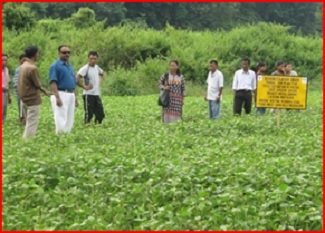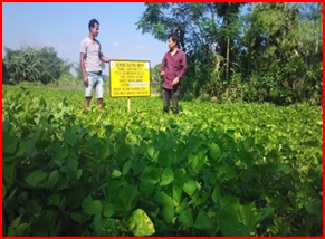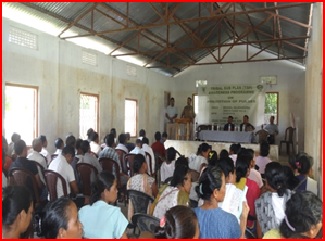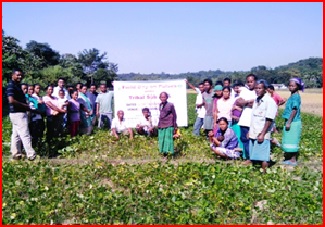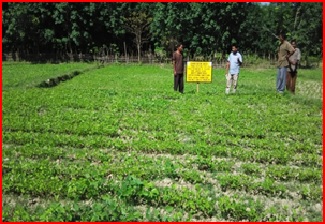Popularization of Rabi Blackgram (Vigna radiata) and Greengram (Vigna mungo) variety under rice fallows of Garo Hills, Meghalaya: A Success story
Naorem Arunkumar Singh, Tanmay Samajdar* and Tarun Kumar Das Krishi Vigyan Kendra, West Garo Hills, Tura, Meghalaya *Division of Social Science,ICAR- NEH Region, Umiam, Meghalaya
Introduction:
Agriculture and allied fields are the major income generating sources for more than 70% of population in Garo Hills, Meghalaya. According to 2011 census, agriculture provides full time employment to 13.56 per cent of total workers. Out of total land holdings 70 -75% comes under small and marginal farmers. Pulse is one of the important crops consumed by every household of Garo Hills, Meghalaya. The climate of Garo Hills is largely controlled by South-West monsoon and seasonal winds. The average rainfall is 2800-3300 mm of which more than two-thirds occur during the monsoon, winter being practically dry. Garo Hills shows different types of soil as the provenance differs widely. Red Gravelly Soil and Red Sandy Loam in the hilly slopes and Clayey Loam in the plains are the common soil types. The soils are acidic in nature and comparatively rich in organic matter and nitrogen but poor in phosphorous and low to medium potash. Some districts of Garo Hills experienced drought situation from last decades but the agricultural productivity is sustaining due to adoption of improved agricultural technological interventions. Traditionally pulses have been considered an important element of cropping systems. They are the integral part of many diets across the globe and they have great potential to improve the human health, conserve soil fertility, protect the environment and contribute to global food security. Pulses are one of the important and most nutritious rabi pulses. It has the potential to cover the risk of rainfed farming. It is also used as a cover crop to check the soil erosion in problem areas. The plants are ploughed back into the soil as green manure also.
Problems Identified:
Cultivation and production of pulse crops, the farmers faced certain persistent problems such as insects and diseases, uncertain rainfall, excessive temperature, technology related constraints etc. The productivity of local pulse varieties in Garo Hills is very low as compared to other parts of the country due to non availability of improved variety and non-application or hesitation to apply chemical fertilizers. The local farmers of Garo Hills districts of Meghalaya are not so much aware about the crop and moreover problems of unavailability of suitable high yielding varieties is a major factor for less production of pulses in the districts. The problem of moisture stress during flowering and pod formation stage of crop is the main issue of the operational villages. The rice fields in rainfed system of Garo Hills, Meghalaya remain fallow in the winter months, offering a window for farmers to grow short duration pulse crops. The introduction of short duration and high yielding varieties are enabling farmers to reap pulses after harvest from rice fallows to boost the production. Therefore, the scientifically production technology and introduction of HYV’s are getting more and more relevant to add another yard in pursuit of sustainability and livelihood improvement of farmers.
Technical support& Intervened by KVK, Tura:
In the operational villages of all the five districts of Garo Hills, Meghalaya, a joint venture programme on cultivation of improved varieties of blackgram and greengram was initiated by the team of KVK, West Garo Hills, Tura, Meghalaya under TSP programme during rabi season 2016-17. In this programme an attempt was made for improvement on existing local cultivars of pulse crops which is already grown in some few areas by utilizing the locally available resources. Nine trainings programmes imparting the knowledge of seed requirement, time of sowing, spacing to be maintained, fertilizer application, plant protection measures and time of harvesting etc. and seven method demonstrations on seed inoculation by biofertilzer Rhizobium were conducted in all the selected villages of all the districts. KVK, West Garo Hills has supplied four improved varieties of blackgram (Kalindi, Uttara, IPU-2-43, Tripura Mas Kolai ) and three of greengram (Meha, Samrat, IPM-2-3) to the selected beneficiaries through Block Development Officers and District Agriculture Officers of all the districts. Field demonstrations were conducted where maintenance of spacing and techniques of sowing were shown to the farmers. A total area of 67.70 ha benefitting 244 farmers in cultivation of blackgram and 131.03 ha of land benefitting 395 farmers for greengram has been covered in all the five districts.
Results:
The results showed that the farmers fetched highest net return with good benefit cost ratio and increase of yield as compare to the local farmers practice in both the crops with improved varieties as shown in Table 1 and 2.
Table No.1. Average yield performance of Greengram varieties of all the districts of Garo Hills, Meghalaya
Table No.2. Average yield performance of Blackgram varieties of all the districts of Garo Hills, Meghalaya
Social Impact:
- Farmers feedback:
Use of scientific technical knowledge in a sustainable way, in blackgram and greengram cultivation to spread over a larger area. Higher productivity, utilization of residual moisture, food security and increased income to farmers. Pulse crops best management practices for the farmers are improved varieties and sowing of seeds timely. Farmers were very grateful to KVK, West Garo Hills and very much enchanted with the technology where input cost of cultivation was drastically reduced from their normal cultivation and good monetary return from the produce.
b. Horizontal Expansion:
As a part of extension activity programme, KVK, West Garo Hills, Tura organized field days at the time of harvesting stage so that the nearby local farmers may accept and convince themselves to grow in the next season. After seeing the performance of crops, a total of 57 ha area under blackgram and 35 ha under greengram crops has been expanded for cultivation in five districts of Garo Hills, Meghalaya during the rabi season, 2017.
c. Motivation
The success story and hardworking of all the selected farmers of five districts has encouraged other farmers to grow more pulse crops using the technology which has high income generation for livelihood and they themselves are encouraged from their achievements and interested to expand more cultivation of pulse crops in future. KVK, West Garo Hills will extend suitable support and encouragement for them in future.
Action Photographs:
Demonstrations conducted at West Garo Hills District, Meghalaya
Demonstrations conducted at South West Garo Hills District, Meghalaya
Training and Demonstration conducted at North Garo Hills District, Meghalaya
Field day and Demonstration conducted at South Garo Hills District, Meghalaya
Training and Demonstration conducted at East Garo Hills District, Meghalaya
